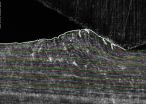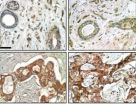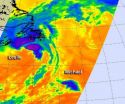(Press-News.org) "We see phenomena normally associated with fluids, not solids," said Srinivasan Chandrasekar, a professor of industrial engineering at Purdue University, working with postdoctoral research associates Narayan Sundaram and Yang Guo.
Numerous mechanical parts, from bearings to engine pistons, undergo such sliding.
"It has been known that little pieces of metal peel off from sliding surfaces," Chandrasekar said. "The conventional view is that this requires many cycles of rubbing, but what we are saying is that when you have surface folding you don't need too many cycles for these cracks to form. This can happen very quickly, accelerating wear."
Findings are detailed in a research paper published in the Sept. 7 issue of the journal Physical Review Letters. The magazine featured the research on the cover and also included a Viewpoint commentary about the work (http://physics.aps.org/articles/v5/100).
The researchers are developing models to further study the phenomena and understand the wide-ranging consequences of such fluidlike flow in metals, Chandrasekar said. The findings might also lead to improved surface quality in materials processing.
The team observed what happens when a wedge-shaped piece of steel slides over a flat piece of copper. It was the first time researchers had directly imaged how sliding metals behave on the scale of 100 microns to1 millimeter, known as the mesoscale.
The observations show how tiny bumps form in front of the steel piece, followed by the swirling vortex-like movement and then the creation of shallow cracks. The folding and cracking were most pronounced when the steel piece was held at a sharp angle to the copper surface.
The researchers hypothesize that the folding and cracking is due in part to a phenomenon similar to "necking," which happens as a piece of metal is stretched.
Researchers used a specialized laboratory setup that included a high-speed camera and equipment that applies force to the sliding metals. The behavior was captured in movies that show the flow in color-coded layers just below the surface of the copper specimen. Copper is commonly used to model the mechanical behavior of metals.
"Researchers have never had a good experimental setup to observe this kind of deformation directly," Guo said. "Our setup enables us to see the entire history of this fluidlike behavior as it occurs, whereas more conventional experiments rely on still images taken after the experiment is finished."
Metals are made of groups of crystals called grains. Metal surfaces that have smaller grains may be less susceptible to the folding and crack formation.
"We need to explore what role grain size plays," Chandrasekar said. "We think there should be some grain size below which this folding mechanism may be less active. We need to explore why, under what conditions, solid metals behave like fluids."
INFORMATION:
The research has been funded by the National Science Foundation, U.S. Army and General Motors.
Writer: Emil Venere, 765-494-4709, venere@purdue.edu
Sources: Srinivasan Chandrasekar, 765-494-3623, chandy@purdue.edu
Narayan K Sundaram, nsundara@ecn.purdue.edu,
Yang Guo, guo24@purdue.edu
Related websites:
Srinivasan Chandrasekar: https://engineering.purdue.edu/IE/People/profile?resource_id=9203
IMAGE CAPTION:
This frame from a high-speed camera sequence reveals surprising behavior in a solid piece of metal sliding over another. The research is providing new insights into the mechanisms of wear and generation of machined surfaces that could help improve the durability of metal parts. (Purdue University School of Industrial Engineering image/N. Sundaram and Y. Guo)
A publication-quality image is available at https://news.uns.purdue.edu/images/2012/chandrasekar-metals.jpg
ABSTRACT
Mesoscale Folding, Instability, and Disruption of Laminar Flow in Metal Surfaces
Narayan K. Sundaram,* Yang Guo, and Srinivasan Chandrasekar
Center for Materials Processing and Tribology, Purdue University
Using in situ imaging, we report surface fold formation and fluidlike flow instabilities in sliding of annealed copper. We demonstrate using simulations that folding is principally driven by grain-induced plastic instability. The phenomenon shows remarkable similarities with Kelvin-Helmholtz-type flow instabilities in fluids. While such instabilities have been conjectured to exist in sliding interfaces at the nanoscale, we find vortices and folding in metals at the mesoscale. The occurrence of folds impacts many applications, including surface generation processes and tribology.
Sliding metals show fluidlike behavior, new clues to wear
2012-09-12
ELSE PRESS RELEASES FROM THIS DATE:
NASA's Global Hawk investigating Atlantic Tropical Depression 14
2012-09-12
NASA's Hurricane and Severe Storm Sentinel (HS3) airborne mission sent an unmanned Global Hawk aircraft this morning to study newborn Tropical Depression 14 in the central Atlantic Ocean that seems primed for further development. The Global Hawk left NASA's Wallops Flight Facility on Wallops Island, Va., this morning for a planned 26-hour flight to investigate the depression.
NASA's latest hurricane science field campaign began on Sept. 7 when the Global Hawk flew over Hurricane Leslie in the Atlantic Ocean. HS3 marks the first time NASA is flying Global Hawks from the ...
Scrub jays react to their dead
2012-09-12
Western scrub jays summon others to screech over the body of a dead jay, according to new research from the University of California, Davis. The birds' cacophonous "funerals" can last for up to half an hour.
Anecdotal reports have suggested that other animals, including elephants, chimpanzees and birds in the crow family, react to dead of their species, said Teresa Iglesias, the UC Davis graduate student who carried out the work. But few experimental studies have explored this behavior.
The new research by Iglesias and her colleagues appears in the Aug. 27 issue of ...
Protein linked to therapy resistance in breast cancer
2012-09-12
A gene that may possibly belong to an entire new family of oncogenes has been linked by researchers with the U.S. Department of Energy (DOE)'s Lawrence Berkeley National Laboratory (Berkeley Lab) to the resistance of breast cancer to a well-regarded and widely used cancer therapy.
One of the world's leading breast cancer researchers, Mina Bissell, Distinguished Scientist with Berkeley Lab's Life Sciences Division, led a study in which a protein known as FAM83A was linked to resistance to the cancer drugs known as EGFR-TKIs (Epidermal Growth Factor Receptor-Tyrosine Kinase ...
What are the effects of the Great Recession on local governments?
2012-09-12
Freezing positions and cutting workforces
Trimming pension and health care costs and passing them to employees
Lowering service delivery levels, but not imposing many new fees
Using technology to reduce costs where possible
Receiving added pressure but little help from States and the Federal Government
This important new research sheds light on the challenges faced by city and county governments that must provide most basic services. Unlike federal or state governments, these local governments have limited ability to generate revenue and are often mandated to pay for ...
NASA infrared data reveals fading Tropical Storm Leslie and peanut-shaped Michael
2012-09-12
When NASA's Aqua satellite passed over the Atlantic on Sept. 11 it caught Tropical Storm Leslie's clouds over Newfoundland and peanut-shaped Tropical Storm Michael to its southwest. The Atmospheric Infrared Sounder (AIRS) instrument captured infrared data on Tropical Storms Leslie and Michael when it passed overhead on Sept. 11.
Michael Appears Peanut-Shaped on Satellite Imagery
Tropical Storm Michael forecast to become a remnant low later today, Sept. 11, but as of 11 a.m. EDT Michael still had maximum sustained winds near 45 mph (75 kmh). It was located about 1,090 ...
Yellow lights mean drivers have to make right choice -- if they have time
2012-09-12
A couple of years ago, Hesham Rakha misjudged a yellow traffic light and entered an intersection just as the light turned red. A police officer handed him a ticket.
"There are circumstances, as you approach a yellow light, where the decision is easy. If you are close to the intersection, you keep going. If you are far away, you stop. If you are almost at the intersection, you have to keep going because if you try to stop, you could cause a rear-end crash with the vehicle behind you and would be in the middle of the intersection anyway," said Rakha, professor of civil ...
Genetic make-up of children explains how they fight malaria infection
2012-09-12
Researchers from Sainte-Justine University Hospital Center and University of Montreal have identified several novel genes that make some children more efficient than others in the way their immune system responds to malaria infection. This world-first in integrative efforts to track down genes predisposing to specific immune responses to malaria and ultimately to identify the most suitable targets for vaccines or treatments was published in the Proceedings of the National Academy of Sciences by lead author Dr. Youssef Idaghdour and senior author Pr. Philip Awadalla, whose ...
Scientists discover how the brain ages
2012-09-12
The ageing process has its roots deep within the cells and molecules that make up our bodies. Experts have previously identified the molecular pathway that react to cell damage and stems the cell's ability to divide, known as cell senescence.
However, in cells that do not have this ability to divide, such as neurons in the brain and elsewhere, little was understood of the ageing process. Now a team of scientists at Newcastle University, led by Professor Thomas von Zglinicki have shown that these cells follow the same pathway.
This challenges previous assumptions ...
Uncertain about health outcomes, male stroke survivors more likely to suffer depression than females
2012-09-12
Philadelphia, PA, September 12, 2012 – Post-stroke depression is a major issue affecting approximately 33% of stroke survivors. A new study published in the current issue of Archives of Physical Medicine and Rehabilitation reports that the level to which survivors are uncertain about the outcome of their illness is strongly linked to depression. The relationship is more pronounced for men than for women.
"Male stroke survivors in the US who subscribe to traditional health-related beliefs may be accustomed to, and value highly, being in control of their health," says ...
Information theory helps unravel DNA's genetic code
2012-09-12
DNA consists of regions called exons, which code for the synthesis of proteins, interspersed with noncoding regions called introns. Being able to predict the different regions in a new and unannotated genome is one of the biggest challenges facing biologists today. Now researchers at the Indian Institute of Technology in Delhi have used techniques from information theory to identify DNA introns and exons an order of magnitude faster than previously developed methods. The researchers were able to achieve this breakthrough in speed by looking at how electrical charges are ...





